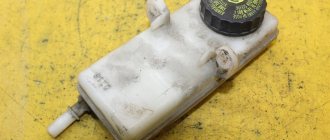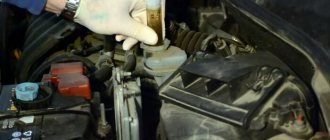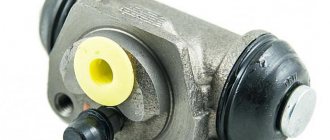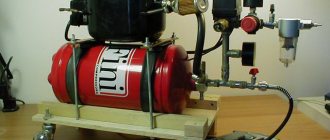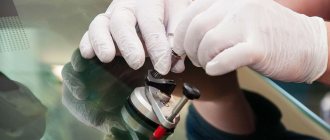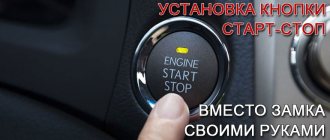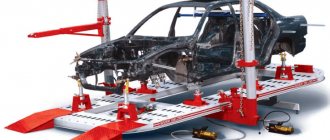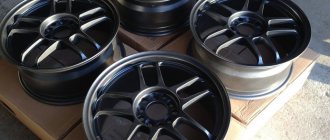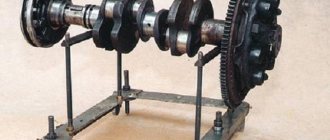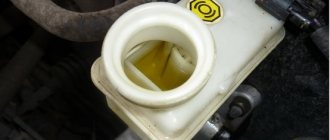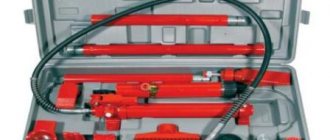Repair work is an integral part of car operation. Sooner or later, some system components fail, so the driver has to send his iron horse for service. Some car enthusiasts prefer to deal with at least trivial breakdowns on their own, which in principle is quite reasonable. But there are also planned repairs, for example, timely replacement of antifreeze, various consumables, and brake fluid. After replacing the latter, the brake system needs bleeding, since there is air left there, which should not happen in everyday life. In this article we will tell you how to bleed your brakes correctly.
Why does the air interfere?
Liquid, unlike air, is practically incompressible, which means it transmits force in full. Along with the brake system, in modern cars the power steering and automatic transmission are hydraulic (operating due to fluid pressure).
Let's imagine a situation where there is a certain amount of air bubbles in the brake fluid pipe of one of the rear wheels.
What will happen in this case when you press the brake? Where there is no air, the fluid will transmit force and the wheel will lock immediately. The air will be compressed and the force transferred to the brake pads will not be enough, the wheel will continue to rotate. For this reason, the car may skid.
When pumping is necessary
After renovation
The brakes will have to be pumped in all cases where the tightness of the system has been compromised:
- Replacement, repair of master or working brake cylinders;
- Damage and replacement of hoses, flaring of brake pipes;
- Repair of other components and elements of the brake system.
Periodic fluid replacement
There is no universal answer to the question “how often to change brake fluid”. If the technical documentation of your car does not clearly indicate the frequency of replacement, it is recommended to do this once every 2 years, or after 50 thousand mileage.
The main reason for replacement is the accumulation of moisture in the liquid. Why is this dangerous?
Moisture lowers the boiling point. Friction during braking causes the pads, calipers and the fluid itself to heat up, even to the point of boiling. When boiling, air bubbles are released, which is why air in the brake system is dangerous, as described above. In addition, water causes corrosion and can freeze. Both are fraught with consequences.
Unsatisfactory performance
As a rule, the driver notices a change in the operation of the brakes: decreased efficiency, pedal failure, slow response to pressure, and so on. In these and other cases, bleeding the brakes can be a solution to the problem.
Why is pumping needed?
Before starting work, you should determine the purpose for which the procedure is being carried out. It helps remove air from the hydraulic system. The reasons for the formation of air in the system include:
- any intervention (for example, during repairs) in the brake system; caliper overhaul;
- depressurization of the system during repairs;
- damage to hoses;
- replacing the brake fluid and reducing it to the minimum level in the brake cylinder;
- reuse of liquid.
Excess air can be detected when braking. Vehicles will be characterized by a sharp stop with increased braking. Pressing the brake pedal will be “soft” with increased travel. If you notice such “behavior” in your vehicle, you should urgently pump it - it is not safe to drive a car in this condition.
Bleeding involves removing air from hoses, calipers and tanks. Actually, it is necessary for the brakes to work smoothly. If there is air in the master brake cylinder, or it has been replaced, then it must be bled first.
Important points
Before you start pumping, you should remember a number of important rules that will help you avoid additional problems.
- Before work, inspect the main components for leaks. If the seal is broken somewhere, bleeding the brakes will be a waste of time and effort.
- Always monitor the brake fluid level in the expansion tank. If it becomes empty during operation, the system will become even more airy.
- Never use an open-end wrench to unscrew fittings - the edges are easily torn off.
- Be sure to clean the fittings from dirt; before pumping, it’s a good idea to spray them with WD-40 and wait 10-15 minutes. Often the fitting becomes tightly “stuck” to the brake cylinder and breaks off when you try to unscrew it. If the fitting does not budge, try gently heating and cooling it several times.
- On vehicles equipped with a brake force regulator (sorcerer), the rear of the vehicle must be loaded before bleeding. You can simulate loading by slipping a screwdriver between the regulator rod and the pressure plate.
- If there are no special instructions from the manufacturer regarding the bleeding order, the following scheme is recommended: rear right wheel, rear left, front right and front left.
Self-leveling
There are two ways to bleed brakes alone: by gravity, and by air pressure.
Gravity flow
Gravity bleeding is more suitable for replacing fluid when there has been no serious airing. Since the old fluid is displaced without pressure, air bubbles may remain in the places where the tubes are bent, in the upper cavities of the cylinders.
The idea is simple: the fittings on the brake cylinders are unscrewed, and new “brake fluid” is constantly added to the reservoir. It is recommended to put transparent tubes on the fittings; they will allow you to see the moment when new liquid begins to flow out.
The disadvantages include low speed and low efficiency.
Air pressure
If you don’t have an assistant, you can bleed the brake system yourself by making a simple device. To do this, you will need an additional expansion tank cap and a tubeless tire nipple.
We cut the nipple into the lid and the primitive device for creating excess pressure is ready. The maximum pressure should not exceed 1-2 atmospheres, otherwise there is a high probability that the expansion tank will burst.
Pressure can be created by a pump, or by using a spare tire. In this case, you will have to make an additional accessory - a hose with valves at both ends.
Now all that remains is to unscrew the bleeder fittings one by one, starting with the wheel farthest from the expansion tank. One end of the transparent hose is put on the fitting, the other is immersed in a container of suitable size.
Slowly unscrew the fitting so that the brake fluid mixed with air bubbles begins to leave the system. When we see that the air has run out (for this we need a transparent tube), we tighten the fitting.
Before moving on to the next wheel, be sure to check the fluid level in the tank and top up if necessary.
Alternative methods
Procedure
Success and high-quality pumping of the brake system lies in following the entire technology of action:
- The first step is to replace the fluid in the GTZ tank or check its quantity and, if necessary, top it up to the maximum level.
- For more comfortable work, it is necessary to clean all air release valves on each wheel from dirt, dust and deposits.
- According to the correct sequence provided in the instructions, it is necessary to unscrew the fitting plug on the desired wheel and attach the prepared hose over the valve.
- The second end of the tube is placed in a previously prepared container with brake fluid.
- The partner progressively presses the brake pedal from 3 to 5 times and at the last movement fixes the pedal in the pressed position.
- At this time, you need to unscrew the air valve halfway. After opening the valve, liquid along with air bubbles will begin to flow through the tube into the container. When the pressure of the liquid escaping into the container disappears, the valve can be screwed back firmly, and your partner can release the brake pedal.
- The process may have to be repeated several times on each node. The main thing is to maintain the wheel sequence and control the amount of fluid in the master cylinder reservoir.
After pumping is completed, you need to make sure that the fitting plugs are tight and that the brakes are operating. After the test, if successful, the brake operation will return to normal. If the driver still feels problems in operation, then perhaps attempts to bleed the brakes with their own hands were unsuccessful, or there is a problem with the wear of the pads or discs.
Bleeding the brakes with an assistant
This method does not require additional devices; all actions are performed in the car with the ignition turned off. The assistant's task is to create pressure in the brake system.
If a person is doing this for the first time, explain to him how important coordination of actions is; he makes movements only at your command. Under no circumstances should you release the pedal before you tighten the fitting. If this happens, the system will suck in air and you will have to start the bleeding procedure all over again.
- Unscrew the cap of the expansion tank and fill it to the maximum possible level.
- Take a place at the right rear wheel, put a tube on the fitting, and immerse the other end in a container. It is important that the other end is in the liquid. Then, even if the assistant releases the pedal ahead of time, it will be drawn into the system, not air.
- On command, the assistant pumps the brake pedal until it becomes hard and loses its range.
- Without releasing pressure on the pedal, the assistant reports readiness.
- You slowly unscrew the fitting and watch how the “brake fluid” comes out along with air bubbles.
- When the pedal goes to the floor at about 3/4 of its travel, the assistant immediately reports this so that you tighten the fitting.
- As soon as this is done, the assistant begins to pump the pedal again. The number of iterations depends on the amount of air.
- If no air bubbles are observed after 3-5 iterations, move on to the next wheel. Don't forget to check the level in the tank.
Errors when bleeding the brakes
Before you bleed your brakes correctly, it’s worth considering three common mistakes that are made when doing this. Therefore you CANNOT :
- Mix different brake fluids . If you mix mineral brake fluid with glycol, it will damage the rubber cuffs of the hydraulic drive and clog the system with clots. It is also not recommended to mix liquids of different classes (DOT 3, DOT4, DOT5), since they have different boiling points and this will reduce their characteristics.
- Allow the brake fluid level to drop significantly . If you do not monitor the brake fluid level in the reservoir and it drops below the minimum level, air will enter the brake system.
- Create high pressure in the brake reservoir . When pumping the brakes yourself, do not overdo the pressure created in the reservoir, otherwise it may rupture. Recommended pressure is 0.8 atmospheres.
ABS brakes
The braking system is constantly being improved, and the presence of ABS in the first generations of the car did not in any way affect the method of pumping the brakes. Now EBD, BAS, ESP, SBC and other auxiliary functions have significantly complicated the process, and often made it impossible at home.
Hydraulic accumulator, pump, hydraulic valves - the presence in the system of these components controlled by the ECU requires serious diagnostic equipment. Therefore, if the instructions for the car do not contain clear instructions for bleeding and you are not sure of the correct actions, it is better to contact a service station.
Don't joke with the brakes!
How to bleed ABS brakes
Bleeding the brake systems of cars equipped with ABS may vary. The fact is that with “regular” ABS the entire anti-lock braking system is located in one module. A car equipped with an ESP system has an additional pump that, if necessary, supplies brake fluid either selectively to individual working cylinders or, with emergency braking assistance, to the vacuum booster. Therefore, the methods for removing air from the circuits may differ. It is advisable to carefully study the car’s operating manual or go to a car service center before bleeding the brakes.
